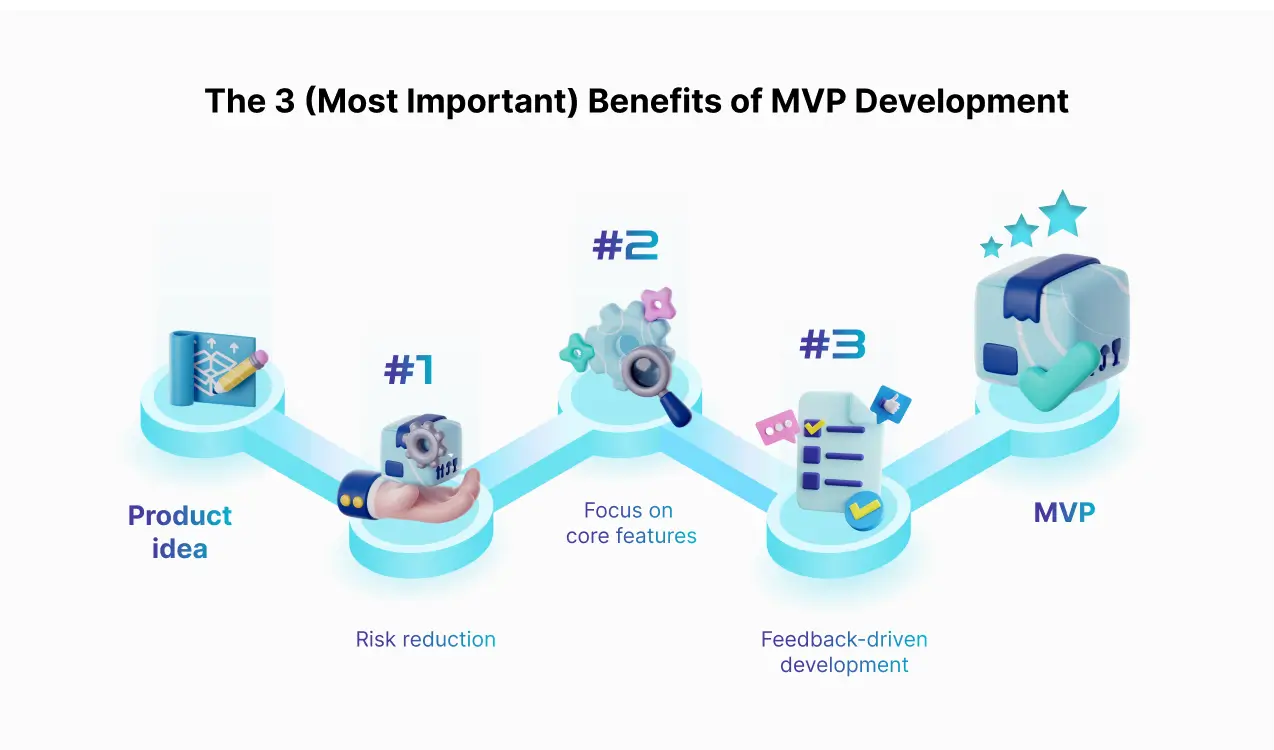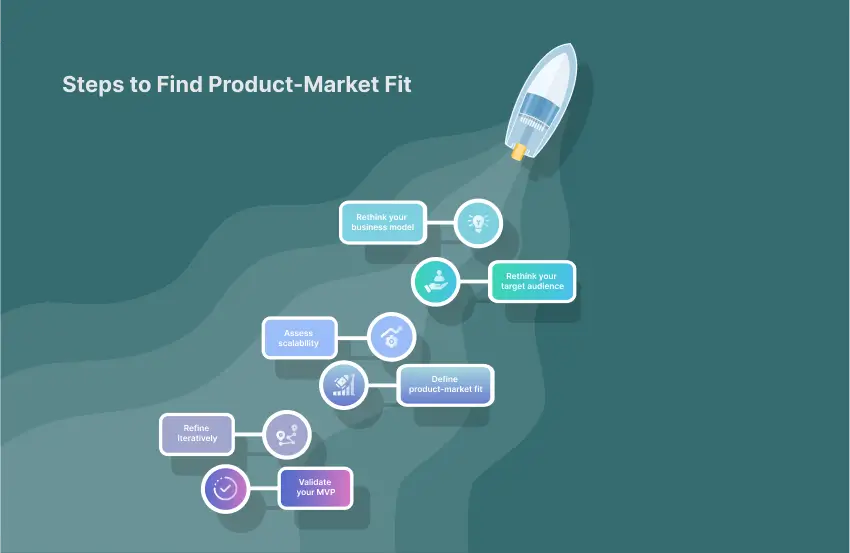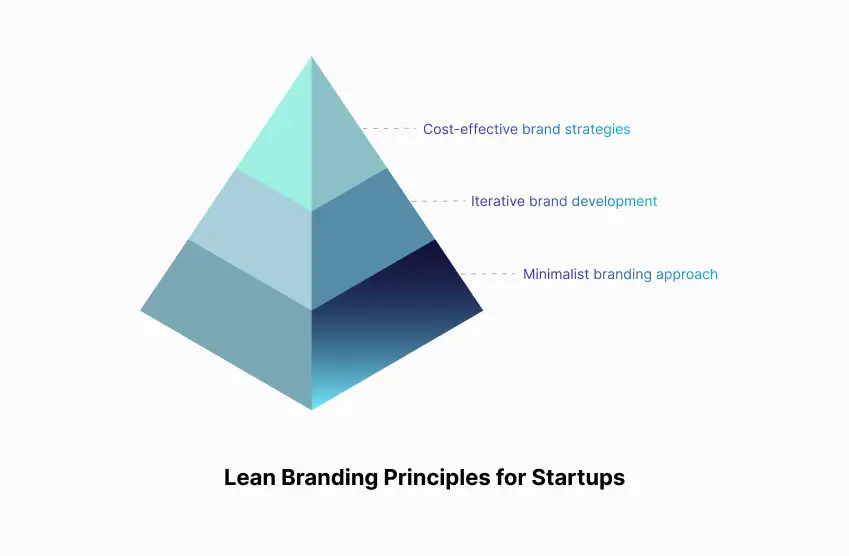In the dynamic tech startup landscape, turning a raw idea into a thriving product in the market is a journey filled with both hurdles and potential wins.
Central to this process is the concept of the Minimum Viable Product (MVP), crucial for testing and growth within the startup world. However, the work doesn’t stop at MVP creation.
The next, and perhaps more critical step, is reaching product-market fit – where your product precisely meets market demands.
This article is crafted for tech and SaaS startup leaders like you. Our goal?
To guide you through the critical transition from MVP to product-market fit.
We’ll dive into lean strategies that smooth this transition and lay the groundwork for your startup’s sustained growth and scalability. By mastering these
strategies, you can steer your startup through market complexities with
confidence and secure a strong position for your software product!
Understanding MVP and Its Role in Startups
An MVP is more than just a basic product version. It’s a focused approach for learning about customer preferences, market needs, and the practicality of your product idea with minimal effort.

MVP lets startups test their concepts with a basic, functional product version, gather critical feedback, and make informed future development choices.
So, why does it matter so much?
MVP is crucial in the startup realm for several reasons:
- Risk reduction: It lessens the risk of heavy investment in a product that might not click with your audience.
- Focus on core features: It helps pinpoint and concentrate on key features that satisfy your customers’ primary needs.
- Feedback-driven development: Early and consistent feedback ensures your product evolves in line with market requirements.
Incorporating MVP means adopting a mindset that values flexibility, customer insights, and ongoing learning.
Lean Strategies for MVP Development
Developing an MVP is a balancing act between speed, efficiency, and strategic foresight.
Lean strategies in MVP development are not just about cutting costs but also smart, agile decision-making that aligns closely with your startup’s goals and customer needs. By adopting these strategies, startups can create a product that is not only viable but also poised for future success.
Identifying Core Features
The essence of MVP development is pinpointing vital features that solve the central problem your product targets. This involves in-depth market research and understanding customer challenges.
Focus on the ‘must-haves’ rather than ‘nice-to-haves’ to keep the MVP cost-effective and valuable for users, increasing its success potential.
Validating the Market Need
It’s crucial to test a product in the actual market since startups often mistakenly assume market needs.
Lean MVP development requires engaging with potential customers through interviews, surveys, or beta releases to a user group.
Aim to collect both qualitative and quantitative data to confirm or refute your market assumptions. This step ensures your MVP resonates with your audience and meets real market demands.
Iterative Development and Feedback Loop
Iterative development is key in MVP strategy. Follow a cycle of building, measuring, and learning.
Release the MVP, collect feedback, analyze it, and iterate. This quick, ongoing loop allows for rapid changes and improvements based on real user feedback.
This approach not only refines your product but keeps it in line with evolving customer and market trends, boosting its market viability.
Resource Management and Cost-Efficiency
Effective resource management is crucial in MVP development. This includes managing finances, time, and human resources.
Focus on tasks with the highest ROI.
Apply lean methods like Agile and Scrum for efficient development. Utilize automated tools and processes to speed up development and cut costs.
Aim for maximum output with minimal input, ensuring every resource contributes to a market-ready product.
Transitioning from MVP to Product-Market Fit

Understanding Product-Market Fit
Product-market fit is when your product is finely tuned to meet a viable market’s demands effectively.
It’s lots more than just having an impressive product. You’d need to make sure the product serves enough customers in a scalable manner.
This phase involves refining your MVP based on feedback, tweaking your business model, and aligning your product more closely with market demands.
Lean Strategies for Evolving the MVP
- Feedback integration: Post-MVP, make customer feedback a priority. This might involve adding new features, adjusting existing ones, or eliminating unneeded elements. Stay focused on customer needs and data-driven decisions.
- Metrics monitoring: Set up key performance indicators (KPIs) that are relevant to your product and market. Keep a close watch on these metrics to understand user behavior, product performance, and market reactions. Metrics like customer acquisition cost, lifetime value, churn rate, and daily active users offer insights into your product-market fit.
- Continual market research: As your product and market evolve, so should your research. Stay ahead of trends and understand changing customer needs through competitor analysis, customer surveys, and industry trend monitoring.
- Pivoting when necessary: Be ready to pivot if the data indicates your product isn’t meeting market needs as expected. Pivoting might mean significantly altering your product based on your market and customer learnings.
Balancing Feature Additions
When evolving from an MVP, resist the urge to overload your product with features.
Each new feature should be evaluated for its contribution to product-market fit. Consider if the feature will help achieve product-market fit or if it’s straying from your core value proposition.
Building a Scalable Business Model
As your product develops, so should your business model, ensuring scalability. This includes considering pricing strategies, sales channels, and customer support systems.
A scalable business model can grow without being hindered by its structure or resources.
Scalability and Growth Post-MVP
Achieving product-market fit with your MVP is a significant milestone, but it’s just the beginning of another critical phase for any startup: scaling.
Lean scaling is about strategically growing your product in a smart and sustainable way. Each step in this process should contribute positively to the overall value proposition of your product, enhancing its reach and capabilities while maintaining its core essence.
Lean Scaling Strategies
- Infrastructure scalability: As your user base grows, ensure that your product’s infrastructure can scale accordingly. This could involve upgrading server capabilities, optimizing for scalable architecture, and employing cloud technologies for flexibility and efficiency.
- Thoughtful feature expansion: As you scale, be selective about feature additions. Each new feature should align with user needs and overall business goals. Prioritize functionality that adds real value and avoid overcomplicating the product.
- Quality and performance maintenance: Growth should not compromise the product’s quality. Continually invest in testing, customer support, and quality assurance practices to maintain the standards your early adopters appreciated
Implementing Sustainable Growth Strategies
Sustainable growth involves expanding your business at a pace that is manageable and does not undermine your startup’s values, product quality, or financial health.
- Efficient customer acquisition: Focus on channels that offer the best return on investment for customer acquisition. This might involve refining your marketing strategies or capitalizing on organic growth tactics such as SEO and content marketing.
- Streamlining operations: Maintain a lean approach to your operations. This could mean automating routine tasks, adopting effective project management tools, and keeping a lean team structure.
- Agility in product development: Keep your development process agile as you scale. This flexibility allows for quick adaptation to market shifts and user feedback, keeping your product relevant and competitive.
Focusing on Customer Retention and Diversification
- Customer retention: Prioritize retaining customers through excellent service, ongoing engagement, and regular product improvements. Retention strategies are often more cost-effective and beneficial than acquiring new customers.
- Diversification: Explore new customer segments, develop complementary products, or enter new markets. Diversification can provide additional revenue streams and reduce risks associated with relying on a single market segment.
Data-Driven Growth
Use data and analytics to inform your growth strategies. Understanding user behavior, market trends, and key business metrics enables you to make decisions that drive sustainable growth, keeping your startup on a path of healthy expansion.
Lean Strategies for Branding

In the transition from MVP to product-market fit, a key yet often overlooked aspect is efficiently developing your brand identity and messaging.
This isn’t about large-scale campaigns or heavy investments in branding; it’s about smart, lean strategies that create a strong brand presence without overextending resources.
Minimalist Branding Approach
Start with a minimalist approach. Focus on what’s essential about your brand.
What are the one or two things you want your customers to remember? This could be your unique selling proposition or a particular problem your product solves.
Keep your messaging clear and simple, avoiding the clutter of over-complicated branding.
Iterative Brand Development
Just like your product, your brand should evolve based on customer feedback and market response.
Start with a basic but strong brand message and visual identity. As you gather more insights from your MVP users, refine your brand to better resonate with your target audience. This iterative process ensures your branding remains relevant and impactful.
Lean Digital Presence
In today’s digital world, a lean yet strong online presence is crucial.
Instead of spreading yourself thin across all platforms, identify where your target audience spends the most time. Focus your efforts on these channels to build a consistent and strong brand presence.
Use analytics to understand the performance of your messaging and adjust accordingly.
Integrating Branding with MVP Feedback
Link your branding efforts closely with the feedback you receive on your MVP.
If users praise a specific feature or benefit, make that a key part of your brand message. If there’s a particular customer need that your product addresses, highlight this in your branding.
This alignment ensures that your brand messaging is always in sync with your product’s strengths and customer expectations.
Cost-Effective Brand Strategies
Finally, be mindful of budget constraints. Lean branding means achieving maximum impact with minimal expenditure.
Utilize cost-effective tools and platforms for your branding efforts. Focus on content that adds value and engages your audience rather than expensive advertising.
CompileCrew's Approach to Finding Product-Market Fit
At CompileCrew, we recognize that the path from MVP to market fit varies per startup. This is why we offer customized solutions that align with each client’s unique needs and goals:
- Bespoke development roadmaps: We create dynamic, adaptive roadmaps considering where your startup is and aims to be.
- Advanced data analytics integration: From the start, we integrate analytics tools into the MVP for ongoing user behavior and feedback analysis, guiding precise product adjustments.
- Customer-centric iteration process: By understanding user interactions, we refine the MVP to resonate deeply with the target market.
- Strategic feature evolution: We carefully assess each feature for its long-term value, prioritizing those that enhance user engagement and retention.
- Lean pricing model development: Understanding that pricing is a crucial component of market fit, we employ a lean approach to optimize pricing models. This involves analyzing competitor pricing, understanding customer value perception, and experimenting with different pricing structures. We aim to find a pricing model that not only reflects the value of your product but also aligns with your target market’s expectations and willingness to pay.
- Collaborative ecosystem: We believe in partnership, working closely with startup leaders and development teams to ensure alignment with the startup’s vision.
Conclusion

Sheena Ambarin
Sheena is a growth hacker at CompileCrew. She loves everything about technology and startups. When she’s not in strategy mode, you’ll find her recharging with some rock and metal music.


